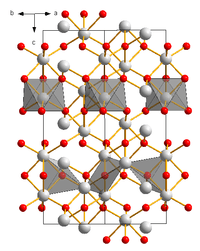Vanadium(III) oxide
 | |
| Names | |
|---|---|
| Other names
Vanadium sesquioxide, Vanadic oxide | |
| Identifiers | |
| 1314-34-7 | |
| PubChem | 518710 |
| RTECS number | YW3050000 |
| Properties | |
| V2O3 | |
| Molar mass | 149.881 g/mol |
| Appearance | Black powder |
| Density | 4.87 g/cm3 |
| Melting point | 1,940 °C (3,520 °F; 2,210 K) |
| Solubility in other solvents | Insoluble |
| Structure | |
| Crystal structure | Trigonal (karelianite), hR30 |
| Space group | R-3c h, No. 167 |
| Except where noted otherwise, data is given for materials in their standard state (at 25 °C (77 °F), 100 kPa) | |
| | |
| Infobox references | |
Vanadium(III) oxide is the inorganic compound with the formula V2O3. It is a black solid prepared by reduction of V2O5 with hydrogen or carbon monoxide.[1][2]It is a basic oxide dissolving in acids to give solutions of vanadium(III) complexes.[2] V2O3 has the corundum structure.[2] It is antiferromagnetic with a critical temperature of 160 K. [3] At this temperature there is an abrupt change in conductivity from metallic to insulating.[3]
Upon exposure to air it gradually converts into indigo-blue V2O4.[3]
In nature it occurs as the very rare mineral karelianite.
References
- ↑ Handbook of Preparative Inorganic Chemistry, 2nd Ed. Edited by G. Brauer, Academic Press, 1963, NY. Vol. 1. p. 1267.
- ↑ 2.0 2.1 2.2 Greenwood, Norman N.; Earnshaw, Alan (1997). Chemistry of the Elements (2nd ed.). Butterworth-Heinemann. ISBN 0080379419.
- ↑ 3.0 3.1 3.2 E.M. Page, S.A.Wass (1994),Vanadium:Inorganic and Coordination chemistry, Encyclopedia of Inorganic Chemistry, John Wiley & Sons, ISBN 0-471-93620-0
| ||||||